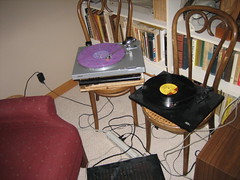Bike Ride out E. Canfield
What follows is the first of (hopefully) many "Bike Ride" posts. Detroit is a bike-friendly town. It wasn't necessarily designed to be bike-friendly, but losing 50% of its population in half a century and maintaining an extensive, out-of-date network of paved roads provides my road bike and I with a lot of room. Last Sunday morning (7/23), I headed out to the Eastside along Canfield with my camera. E. Canfield is home to at least 25 churches (I lost count). The occupancy rate of these churches appears to be much higher than the occupancy rate of any other type of building you'll find along the road. In fact, it appeared that every church I passed was holding a Sunday morning service. The following photographs feature a variety of churches (storefronts, cathedrals, etc.) as well as a number of other things that caught my eye on this bike ride...

St. Josephat is one of the last remaining buildings from the Hastings Street era.

A city park at Canfield and Russell offers an interesting view of downtown.

St. Albertus church.

You can worship, but you better not try to learn. The St. Albertus school is abandoned.

The polka dot bus.

F.I.J.? Catchy...



Canfield takes a hiatus for an abandoned building.

An electronically gated house of worship.

Bike tires!


Arts and Crafts style of architecture.



Industry interrupts Canfield again. For now, it's an operating factory.

The unfinished R&B murals of the abandoned Canfield Market.

There's lots of parking on Canfield, but sometimes you want to get a really sweet lawn spot.

Lush urban prairie.

Open doors welcome you to this C.O.G.I.C. at St. Aubin and Canfield.

I'm sad I have to miss this...
Next Post
Previous Post

St. Josephat is one of the last remaining buildings from the Hastings Street era.

A city park at Canfield and Russell offers an interesting view of downtown.

St. Albertus church.

You can worship, but you better not try to learn. The St. Albertus school is abandoned.

The polka dot bus.

F.I.J.? Catchy...



Canfield takes a hiatus for an abandoned building.

An electronically gated house of worship.

Bike tires!


Arts and Crafts style of architecture.



Industry interrupts Canfield again. For now, it's an operating factory.

The unfinished R&B murals of the abandoned Canfield Market.

There's lots of parking on Canfield, but sometimes you want to get a really sweet lawn spot.

Lush urban prairie.

Open doors welcome you to this C.O.G.I.C. at St. Aubin and Canfield.

I'm sad I have to miss this...
Next Post
Previous Post
Labels: Bike Rides, Detroit, Eastside, Religiosity

